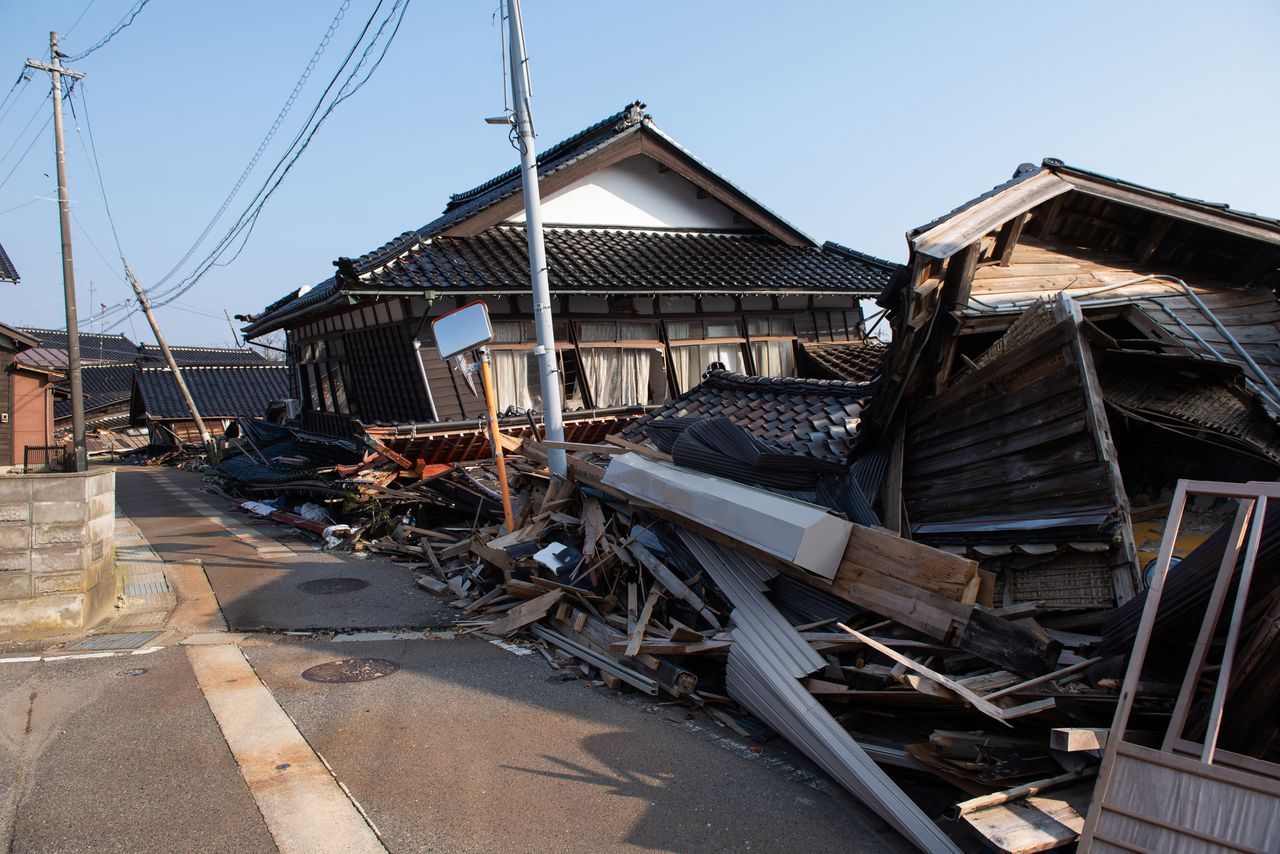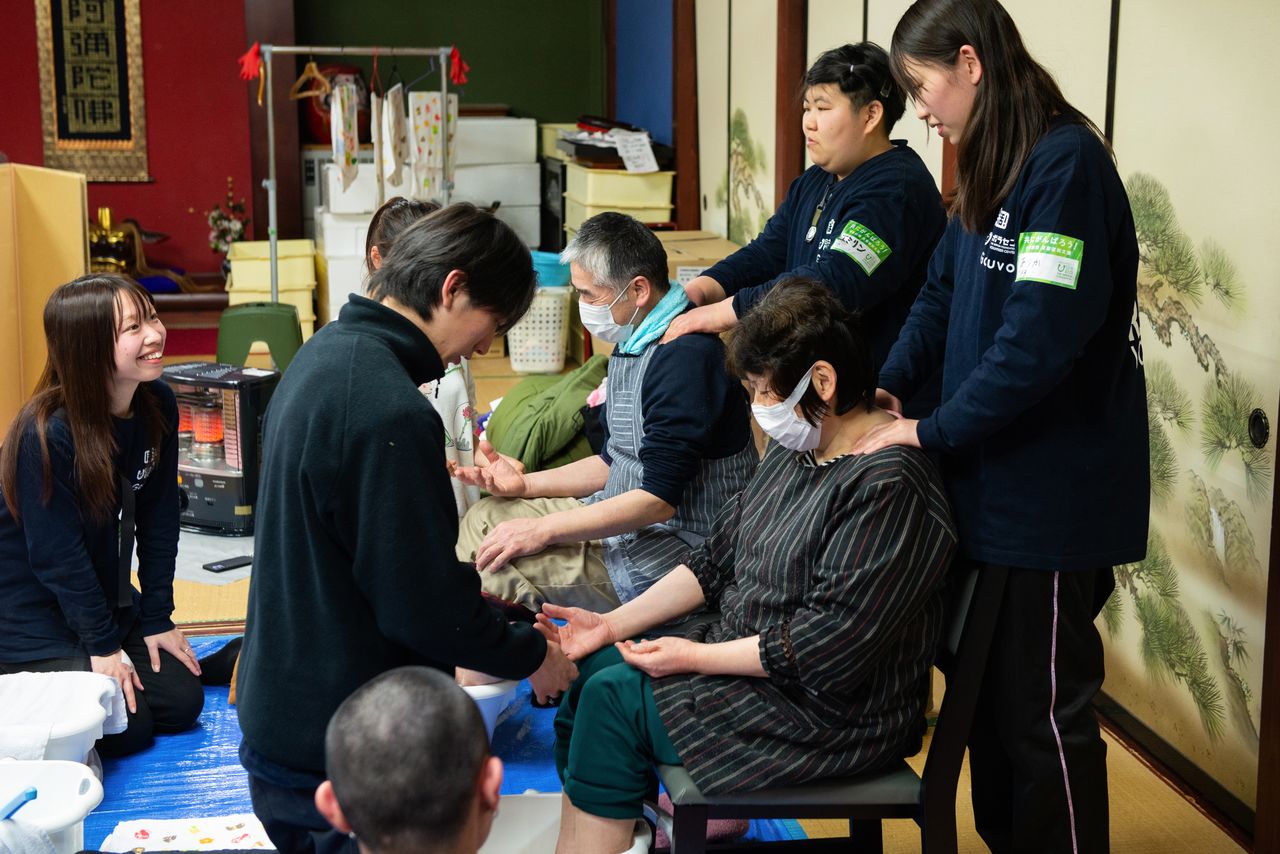
Team Effort: Student Volunteers Help in Earthquake-Hit Noto Peninsula
Disaster Lifestyle- English
- 日本語
- 简体字
- 繁體字
- Français
- Español
- العربية
- Русский
Words of Advice
We followed the activities of a group of young volunteers from the Tokyo-based Nippon Foundation Volunteer Center during relief efforts in Suzu, Ishikawa Prefecture. The members, part of Group 6 of the NFVC, participated in an online handover meeting prior to their on-site relief work. During the meeting, a student from the group who was taking part in disaster relief work for the first time asked if there was anything that participants should avoid doing in the disaster zone. A young woman from the fifth volunteer group advised workers to refrain from asking survivors questions that might bring back bad memories, but stressed that it was more important that volunteers ask themselves what they can do to help, and act on it. Having previously carried out disaster relief work as a volunteer in Group 1, her experience provided valuable guidance for new volunteers.

The members of the NFVC’s Group 6 had never met before, but worked closely together as a team. (© Kodera Kei)
NFVC staff arrived in quake-damaged areas of the Noto Peninsula on January 4, three days after a magnitude 7.6 temblor struck the area. They helped with emergency road repairs and the search for missing persons, while also gathering information before volunteers were dispatched from January 17. The volunteers mainly provide support for the Nippon Foundation’s disaster relief team and other NPO’s working in the area, helping wherever needed.
Suzu, near the northern tip of the Noto Peninsula, was one of the worst-affected area. Over 3,000 homes were destroyed in the city and a further 2,500 were heavily damaged. Because of the distance from populated centers such as Kanazawa, relief and reconstruction work has progressed slowly. When we visited in mid-March, water and power had yet to be restored in many places.

A collapsed home in Takojima. (© Kodera Kei)
Stark Reality of the Disaster Zone
Members of Group 6, who were dispatched from March 11 to 16, mostly worked alongside staff of Rescue-Assist, an NPO working from an evacuation center in the Oritomachi area of Suzu. More experienced staff from the NPO performed maintenance work on homes, operating heavy machinery and other equipment, while the students cleaned the inside of residences and removed debris.

The volunteers remove debris and other tasks that do not require special skills. (© Kodera Kei)
A student clearing debris described his experiences: “The reality you see here is completely different to the impression you get online and from the television news.”
A building may appear relatively undamaged from the outside, but stepping inside reveals rooms with overturned furniture and strewn glass. Noto is very damp in winter from the heavy snows it receives, and most homes have clay walls that help control moisture but which also throw up clouds of dust when they collapse. Over half of the residents of Suzu’s are seniors, and as many live alone, it is almost impossible for them to clean up their homes unassisted. Seeing this reality first-hand, the students grew even more motivated to help.
Rescue-Assist’s Kawashima Hiroyoshi, who directed the volunteer’s work on-site, shared a message he received from the daughter of an evacuee couple who lives away from home. “She told us she hoped to be able to ease her parents’ suffering after they returned home from the evacuation center,” he explained. “I hope the students will apply themselves to the relief effort with empathy for such feelings.”

Kawashima Hiroyoshi (second from right) giving instructions to the student volunteers. (© Kodera Kei)
Listening to the Needs of Elderly Survivors
A student on her second volunteer stint described the difference between her two visits. “Last time, our main jobs was distributing food and giving foot baths,” she says. “Needs change constantly, and the mood at the evacuation center has completely changed too.”
Construction of temporary housing is ongoing, but many people have moved into provisional housing in Kanazawa and elsewhere. The evacuation shelter, which initially housed almost 500, had only 50 evacuees when we visited.

A volunteer knocks down a broken wall with a sledgehammer. (© Kodera Kei)
The longer evacuees stay in the shelter, the more anxious they get about their homes. Even buildings that suffered little damage quickly fall into disrepair without maintenance. Repair and reinforcement work as well as cleaning are essential before occupants can return.
At one damaged home near the fishing port of Noroshi, an elderly woman describes how she left housing in Kanazawa a few days earlier and moved back into the shelter, declaring that “I was worried about my home.” The shelter has been built on a hill, out of reach of potential tsunami triggered by ongoing aftershocks. Just a 10-minute walk away for an able-bodied person, it is difficult to access for many elderly residents. “My husband’s legs are weak,” the woman sighs. “So when we came to check the house yesterday, it took us an hour and a half to get back up to the shelter.”

A home devastated by the 4-meter high tsunami that struck the area. (© Kodera Kei)
The student volunteers were assigned to repair and clean the second floor and stairway of a home. Clothing and books from toppled cabinets and bookcases were strewn about. Clay had fallen from the walls and the floors were badly damaged. Fortunately, there was no major damage requiring heavy equipment. The students pick up their pace as they grow used to the work and mostly complete their task in half a day.
The homeowner expressed gratitude, saying, “I’m so pleased, because I expected it would take days. It cheered me up having these young people around.”

Student volunteers dust off books before replacing them on the shelf. (© Kodera Kei)
The Great Hanshin-Awaji Earthquake in 1995 is considered the start of the volunteer movement in Japan. After the 2011 Great East Japan Earthquake, many young volunteers, including students, traveled to the affected areas to help reconstruction efforts. But people who went without sufficient understanding of what was entailed often became a burden for organizers, and at times there were too many volunteers. From this emerged a belief in some circles that inexperienced people should stay away.
Kawashima disagrees with this view. “Everyone starts as a beginner,” he declares. “There are lots of tasks in the disaster zone that don’t require special skills, just hands on deck. I hope more people will respond to calls from informed organizations such as NFVC and come to help.”
The foot baths given by student volunteers at the shelter are much appreciated. Life in the cramped evacuation shelter in the cold of winter poses challenges. Foot baths boost blood circulation, potentially warding off colds and deep vein thrombosis. One recipient of a foot bath described the experience, saying, “I feel warm to the core—I’ll sleep well tonight,” while another commented that “the young ones brighten up the atmosphere in the shelter.”

Shōin Elementary School serves as a local shelter. Initially, there were over 500 evacuees, including those who slept in their cars. By the time of our visit, temporary housing had been built on the sports ground, and fewer than 40 people remained in the school building. (© Kodera Kei)
Things that Young People Can Do
In fact, the foot baths have another effect. Many of the survivors hesitate to speak out, despite feeling anxious and unsure of what the future holds. But a foot bath allows them to relax, and while chatting with the young volunteers, they start to open up, which provides valuable insight about the needs of the survivors that government officials and experts at support groups might otherwise miss. NFVC staff share the snippets of information gleaned by the students with the relevant bodies, allowing them to provide better assistance.
A women in her seventies comments that “young people always leave Suzu. It was lovely to chat with someone of that age again.”

An evacuee receives a tender hand massage from a young volunteer. (© Kodera Kei)
Everyone was Once a Novice
One of the group’s last assignments was to retrieve the contents of a badly damaged shed at a house on a hill in Noroshi.

The shed leans precariously to one side, threatening to collapse. (© Kodera Kei)
The students, first ensuring the stability of the shed, work efficiently while checking with the owner about what to dispose of. When he sees them holding his long-forgotten audio equipment, the homeowner, in his seventies, tinkers with the record player. “I can’t throw this away—it cost me half a year of wages when I was younger.” Three of the students carry it to the main house according to his wishes.

In a precious interaction, the man shows the bewildered students the workings of a record player. (© Kodera Kei)
Having supervised the work, Kawashima tells us that “young people who come here for the first time go home with a greater sense of initiative. I hope these kids will come back to help again at some stage.”
People who volunteered as students to assist after the Great East Japan Earthquake are now in their mid-thirties. Although many have work and family commitments, a number of them dropped everything to help on the Noto Peninsula after the quake, providing valuable advice for the student volunteers. Kawashima is emphatic: “Japan is a nation of disasters. The experience we gain here at Noto will be useful in future disasters.”
He notes that he himself was also a novice in disaster relief once. But over the years, he has become a valuable member on the ground. “In the course of just doing what I can, people tell me they appreciate it. That means a lot to me.” He encourages anyone who wants to be of use in the disaster-affected area to come, and he hopes that some will eventually become leaders themselves.
Volunteer Work is All in the Heart
On their last night, the student volunteers give each of their lodge proprietors a foot bath to show their appreciation. The husband is moved to tears at their imminent departure, and his wife asks them to come again. “We definitely will,” they reply.

Foot baths, shoulder rubs, and hand massages. (© Kodera Kei)
At the wrap-up meeting, the students reflect on their experiences at length. “At first, I was hesitant to touch people’s belongings—books and photo albums that are filled with precious memories,” says one volunteer. “I tried to do the best that I could, sensing the unique character and story of each home,” describes another. “Volunteer work is all in the heart,” comments a third.
In just a week of volunteering, novices became experienced, and repeat volunteers became leaders. Everyone had grown wiser: learning to think about what they could do, and putting it into action.
(Originally published in Japanese. Banner photo: Student volunteers giving foot baths at an evacuation center. © Kodera Kei.)